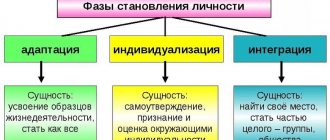Age-related crises represent natural changes in the human psyche depending on the stage of development. They manifest themselves in changes in worldview, the nature of the reaction to familiar things and the basic line of behavior.
At each age, a person performs certain social roles and tasks. With age they also change, which can cause a crisis.
L. Vygotsky, a Soviet psychologist who studied the cognitive development of a child, defined a crisis as a turning point in the normal course of mental development, when changes in the personality structure accumulate, age-related neoplasms appear and lead to sharp shifts in development.
L. Vygotsky called a new formation a qualitatively new type of personality and human interaction with reality, which was absent as a whole at the previous stages of its development. At each age stage, he identified a central neoplasm, which characterizes the restructuring of a person’s entire personality on a new basis, and private neoplasms related to individual aspects of the personality.
Also, a person’s needs and motivations change, which shape their behavior.
According to L. Vygotsky, it is possible to determine the signs of “normal childhood development” and stable stages. Normal development begins at the time of birth and ends at age 17.
Any transition period is accompanied by a stress reaction of the body, against the background of which increased personal irritability develops from misunderstanding and lack of adaptation. This is considered normal. But if the social environment exerts pressure and does not contribute to a smooth passage of the transition stage, then the crisis may drag on or transform into more serious conditions.
The essence of the age crisis
The crisis literally translates as “dividing the roads.” In Chinese, it is written in two characters, one meaning “danger” and the other meaning “opportunity”. In my opinion, this is the most concise and accurate interpretation. It is during crises, including age-related ones, that the active development of the personality occurs, or its “breakdown” if the outcome of the period is unsuccessful.
The term “age crisis” was introduced into use by the Russian psychologist L. S. Vygotsky. Each age has certain norms that psychologists focus on. They help monitor the normality of human development. These same norms of intellectual, emotional, psychophysical and personal development are called age-related development goals. The period of crisis is the period of fulfillment of these tasks, of intense psychophysiological changes.
Every person goes through age-related crises, but the form of expression, intensity and duration vary depending on the person’s socio-economic status, development conditions, and individual personal characteristics.
Despite this, there are still two points of view on the normativity/non-normativity of age-related crises:
- Some psychologists (Freud, Vygotsky, Erikson) consider such transitions to be an integral part of development.
- Other researchers (Rubinstein, Zaporozhets) consider them as a variant of individual deviations.
Symptoms
All crises have their own characteristics. But psychologists have identified a number of signs that belong to the number of symptoms:
- the desire to give up everything and go traveling;
- lack of pleasure from those activities that previously brought it;
- irritability;
- unmotivated aggression;
- feeling of helplessness, emptiness in the soul;
- the desire to feel free physically, for example, during a parachute jump, when driving a car quickly, etc.;
- insomnia or, conversely, drowsiness;
- deterioration of relationships with others;
- poor appetite;
- reluctance to do anything, to develop.
During a crisis, many people leave their families in search of new experiences. They also do impulsive things, such as risking their lives by engaging in dangerous sports. Another symptom is a change in image, often very radical.
According to experts,
men and women experience the crisis differently .
Its course is influenced by the characteristics of their psyche. Representatives of the fair sex are more emotional, therefore, with the appearance of age-related problems, they withdraw into themselves, have a hard time with the appearance of every little wrinkle, and limit communication with family and friends.
Men become aggressive. But at the same time, they practically do not show their emotions, in most cases they believe that nothing terrible is happening.
The difference is also that women are family-oriented, and men are career-oriented. If they don't get what they want, the desire to move on fades away.
Major crises
In psychology, it is customary to distinguish the following age-related crises:
- newborns (from birth to one month);
- one year;
- three years;
- seven years old;
- adolescence (11-12 years);
- youth (17-18 years old);
- youth (20-30 years old);
- maturity (33-35 years);
- middle-aged (45-55 years old);
- late maturity (55-65);
- early old age (66-75 years);
- old age.
The newborn, three-year-old and teenage crises are considered major crises. They account for the restructuring of the relationship between the child and society. The remaining crises are minor. They are less noticeable in appearance and are characterized by an increase in independence and skills. However, at the time of any crisis, children are characterized by negativism, disobedience, and stubbornness.
In adult life, as we see, there are 4 crises:
- The crisis of youth is accompanied by the formation and self-affirmation of a person in the main areas of life and relationships (work, family, love, friendship).
- At the stage of maturity crisis, a person analyzes his successes, the consistency of plans and achievements. Over the next ten years, he consolidates or changes the result.
- A midlife crisis is accompanied by an awareness of loss of strength, beauty, health, and an increase in distance from grown-up children. Often a person is overcome by depression, a feeling of fatigue from routine, sadness from the thought that nothing will be better.
- Late maturity is accompanied by stabilization of the previous state and a gradual withdrawal from social and work activities.
- At the stage of early old age, a person comprehends his life and either recognizes it as unique and inimitable, or understands that it was in vain.
- At the stage of old age, a person rethinks his professional “I”, comes to terms with the inevitable deterioration of health and aging of the body, and gets rid of self-concern. This is the stage of actively accepting the natural end of life.
It is worth noting that childhood crises (the first six) have been studied much more than the crises of adulthood, middle age and old age. The latter are more often considered in the nature of the individual course, although they are also largely due to age-related changes.
Abstract on the topic: “Crises in mental development”
Crises of mental development
Crises in mental development are characterized from a purely external side by features that are the opposite of those periods that are called stable or stable ages. The relevance is due to the fact that teachers and parents and the children themselves are lost during periods of acute age-related crises and often this period is prolonged because they cannot solve the problem of the crisis. This leads to an increase in neuroses in children and psychosomatic diseases. Difficulty in education during the period of acute age-related crises takes on ugly forms. That is why the problem of preventing acute age-related crises is very relevant.
The psychological features of age-related crises in childhood are: restructuring of internal experiences that determine the child’s attitude to the environment; changes in needs and motivations driving his behavior; sharp and major shifts and displacements, changes and fractures in the child’s personality.
The methodological basis of the research is the general scientific principles of cognition, the basic general psychological principles: the principles of development, determinism, a systematic approach to the study of mental phenomena, anthropological and historical approaches to the study of man. The theoretical basis of the study is formed by a set of provisions contained in the cultural-historical theory of L.S. Vygotsky, concepts of critical ages by K.N. Polivanova, the concepts of E. Erikson and J. Piaget, in the works of domestic psychologists: P. P. Blonsky, A. N. Leontiev, D. B. Elkonin, L. I. Bozovic et al.[10, 37]
In the history of child psychology, many authors have empirically noted the unevenness of child development and the presence of special, complex moments in personality development. At the same time, many foreign researchers considered these moments as developmental diseases, and a negative result of the collision of a developing personality with social reality, as well as as a result of a violation of parent-child relationships. Developing a view of age-related crises as forms of deviation of mental development from the normal path, some foreign psychologists came to the conclusion that there may not be crises in development [12, 15].
The first reasonable division of ontogenesis into separate ages was given in Russian psychology by P. P. Blonsky. He also draws attention to special transitional ages and emphasizes that these so-called “transitional ages” present pedagogical difficulties. They are often also called critical ages. The name “critical age” is most firmly established behind the age of puberty. P. P. Blonsky points out the instability of the nervous system and the unbalanced, unmotivated behavior of children during critical periods.[10, 179]
L.S. Vygotsky relies on the ideas of P.P. Blonsky, but approaches the analysis of age dynamics and the place of crises in the general course of development from the general theoretical model of development.[3, 244]
In his work “The Problem of Age,” L.S. Vygotsky, along with general issues of determining age and constructing a new periodization of development in ontogenesis, introduces a theoretical idea of two types of ages—critical and stable. Describing critical periods in development, L.S. Vygotsky writes that from a purely external point of view they are characterized by features opposite to stable, or stable, ages. In these periods, over a relatively short period of time (several months, a year, or, at most, two), sharp and cardinal shifts and displacements, changes and fractures in the child’s personality are concentrated. In a very short period of time, the child changes as a whole, in the main personality traits.[3, 245]
In Russian psychology, the problem of crises has long been considered in the context of problems of development and periodization of childhood.
L.S. Vygotsky
understood development as an internally determined, purposeful process that does not proceed uniformly, but contradictorily, through the emergence and resolution of internal conflicts. Therefore, he paid attention to transitional or critical periods, when, over short periods of time, changes occur in the child that are noticeable to others. According to L.S. Vygotsky, crisis, or critical period, is a time of qualitative positive changes, the result of which is the transition of the individual to a new, higher stage of development. The content of the crisis is the collapse of the existing social situation and the emergence of a new one. The main characteristics of crisis periods, according to L.S. Vygotsky can be called:
- the presence of sudden changes in short periods of time;
- the vagueness of the boundaries of the crisis, that is, the difficulty of defining; the moments of its onset and end;
- conflicts with others and difficulty in raising a child; its loss from the system of pedagogical influence;
- the presence of destruction in development, that is, “the processes of death and coagulation, disintegration and decomposition of what was formed at the previous stage come to the fore.”
L. S. Vygotsky developed a concept in which he considered age-related development as a dialectical process. Evolutionary stages of gradual changes in this process alternate with eras of revolutionary development - age-related crises. Mental development is carried out through a change of stable and critical periods. Within the framework of a stable age, mental new formations mature and become actualized at a critical age. L.S. Vygotsky described the following age-related crises:
1) newborn crisis
– associated with a lack of emotional communication. This is a transition from one form of existence to another. The child adapts to new living conditions.
2) crisis of 1 year of life
– negativism, stubbornness, arbitrariness. Desires do not coincide with possibilities, he wants, but cannot, or, for example, the child is already walking or actively crawling around the house, at this time the range of objects within his reach sharply increases. Adults remove sharp things, cover electrical sockets, place electrical appliances, dishes and books higher with the word “impossible!” Not all of a child’s wishes are fulfilled because his actions may cause harm to himself or others. Of course, the child was familiar with the word “impossible” before, but during a crisis period it becomes especially relevant.
3) crisis. 3 years
– loss of spontaneity. The period of birth of the child’s social “I”. A child at this age insists on his opinion, I myself!. A boy with a protracted crisis decided to draw, but instead of the expected refusal, he received the approval of his parents. On the one hand, he wants to draw, on the other hand, he wants to do the opposite even more. The boy found a way out of this difficult situation: bursting into tears, he demanded that he be prohibited from drawing. After fulfilling this wish, he happily began to draw. Another child read “in reverse” the famous lines of Pushkin: “And not in the blue, and not in the waves, and not in the ocean, and not in the stars, and not in the sky.” The second characteristic of the 3-year crisis is stubbornness. Let's say a child is called home and he refuses to leave the street. Having declared that he will ride a bicycle, he will indeed continue to circle around the yard, no matter what he is tempted with (a toy, dessert, guests), although with a completely sad look.
The baby is trying to determine under what conditions you lose your temper, because conflicts with adults help him build a coordinate system that determines what can be done and what cannot be done.
Aggressiveness. The crisis of the third year of life is the most biting and pugnacious period. This behavior is a direct consequence of stubbornness: if you don’t do what I want, get a shovel in the back!
Greed. Another way to form an image of your “I”. Dividing toys into “mine” and “other people’s” helps the child feel his own boundaries almost “by touch.”
During the transition period, obstinacy may appear. It is directed not against a specific adult, but against the entire system of relationships that developed in early childhood, against the norms of upbringing accepted in the family. The child strives to insist on his desires and is dissatisfied with everything that others offer him and do. An interesting characteristic of the 3-year crisis, which will be characteristic of all subsequent transition periods, is depreciation. What is devalued in the eyes of a child? What was familiar, interesting, and dear before, a 3-year-old child may begin to swear (old rules of behavior are devalued), throw away or even break a favorite toy that was offered at the wrong time (old attachments to things are devalued), etc.
4
)
crisis of 7 years
- During the crisis of 7 years, it is revealed that L.S. Vygotsky calls generalization of experiences.[6,76]
A chain of failures or successes in school, each time experienced in approximately the same way by the child, leads to the formation of a stable affective complex - feelings of inferiority, humiliation, wounded pride or a sense of self-worth, competence, exclusivity. Thanks to the generalization of experiences, at the age of 7 the logic of feelings appears. Experiences acquire a new meaning for the child, connections are established between them, and a struggle between experiences becomes possible.
5
)
crisis 13 years
- (adolescence). Anxiety, instability in decision making, confusion, irritation, pessimistic views.
They rebel against the attitude of adults towards them. A feeling of adulthood appears. At this age, a sense of adulthood appears, and parental authority is devalued. Frequent conflicts arise in the family; often the teenager reacts with protest to any attempts to interfere in his life. At this time, the child already wants everything at once. A person already sees the possibilities that are open to him, but in fact he still does not know how to control his behavior and desires, he is still a child. Needing their parents, their love and care, their opinion, adolescents experience a strong desire to be independent and have equal rights with adults.
6) crisis of 17 years
- smoothly transitions from a teenager. Self-determination in growing self-awareness, self-development, communication with peers and relatives. Lots of plans, but can't solve them.
7
)
the crisis of 21-23 years
is a crisis of a young specialist in psychology. Loses a sense of psychological security. Increased levels of anxiety and decreased perception of stress. Makes mistakes as a young specialist. He does not know how to apply knowledge, does not know how to calculate his strength, fatigue, apathy towards work, difficulties and problems arise when he has an incompetent first boss. Generation conflict is common to all countries. Young people consider themselves progressive, others consider themselves inexperienced, arrogant, problem: the lack of clear quality criteria for assessing the activities of a young specialist; information about the work of a young specialist may be blocked. This crisis coincides with family and personal problems. The beginning of family life. At 25, 60% of men do not intend to get married. Difficult 5 years of family existence coincide with the crisis of a young specialist. During this period, the economic, moral, and psychological foundations of family life are laid. 50% of marriages break up. Psychological incompetence (men and women do not know other things), sexual, pedagogical (different points of view on raising children) incompetence. The birth of a child is very stressful.
8)crisis of 30 years
– a crisis of discrepancy between capabilities and needs. The crisis of initial rethinking and further life planning. It appears earlier in women (called kitchen rebellion). Thinking about the possibility of self-realization. Sensuality awakens. Improve their qualifications, change their profession. Coming out of the crisis of 33 years leads to a stable life. By the age of 30-35, a feeling of fullness of life begins. Happier than when we were teenagers.
9
)
cr.
40 years is a mid-life crisis.
Men feel it acutely. External signs of aging (balding, graying, wrinkles). A realistic self-esteem based on real achievements is formed. Career growth, leading society. They are sensitive to hidden stresses such as the loss of parents, the role of the eldest in the family. Realizes that a person's high position does not always mean a happy life .
10)crisis of 50 years –
a special milestone, a crisis of philosophical rethinking of life. Presenile age. Changes in health due to age-related characteristics (farsightedness, chronic diseases worsen, loss of muscle strength), decreased physical activity, preparation for retirement.
11)retirement crisis
– the crisis and stress are very severe. When the question arises of stopping his professional activity, a severe stressful state arises. Especially if against your will. What will he do in retirement? Myth about old age: mental abilities decline with age, the myth that old people are consumers, the myth about the loneliness of older people, the fear of death. This retirement crisis can be solved: find a new leading social life plan, realize the fact of deteriorating health, accept the thought of death without horror. Get creative, travel, etc.
Having studied the role of the crisis in development and examined the structure of age-related crises, it is theoretically possible to move on to empirical research and identify the relationship between the acute course of the age-related crisis and factors of the social environment (family, school).
Having carried out a brief review of existing theories about the nature of age-related crises, the main provisions of the concept of age-related crises in domestic psychology and Western theories of development. An age crisis is a special period of transformation of the social situation of development: a new formation of the previous period destroys the old social situation of development and provokes the formation of a new one.
Based on the material reviewed, we can give a general definition of the age crisis.
The age crisis consists of a transformation of the social situation of development, in which the old social situation of development is destroyed, and in its place, instead of it, a new one is built. An age crisis may be accompanied by a special syndrome—difficulty in education.
Difficulty in education is one of the symptoms of an acute age crisis.
To develop measures to prevent the acute course of the age crisis, we examined the structure of the age crisis, the reasons for the occurrence of the acute phase of age crises. As one of the main reasons for the acute development of the age crisis, we believe that the nature of the crisis largely depends on specific life situations, family relationships, the education system, and the emotional state of the child. If parents, educators, teachers and other people significant to the child promptly take into account the changes occurring in him and build their attitude in accordance with them, then the course of the crisis is significantly mitigated. Thus, we can assume that the prevention of acute age-related crises (childhood) is the correction of the behavior of adults and children.
In other words, parents need to learn to see in the child’s demands a broader layer of the content of his requests, their ambiguity and diversity.
At each age transition, a child tries to act differently than usual than before. His actions are permeated with the idea of freedom from external control. But a truly free (voluntary) action is always performed in relation to many contexts, meanings, meanings.
In essence, for an adult, the critical period of a child’s development turns out to be a crisis of his own educational system.
The course of a critical period can be successful if the result is a resolution of the crisis, i.e. the adult comes out of it enriched with new, more productive ways of interacting with the child, who understands the reasons for the difficulties that have arisen.
This means that the age-related development of a child provokes the development of the parental (educational) position of adults. If an adult “refuses” the opportunity for development, deliberately or out of ignorance tries to maintain old forms of interaction with the child, this leads to trouble in the relationship with the child, to his own emotional problems, and blocks the child’s development.
Thus, the actions of an adult, just like the actions of a child, change during the critical period. It is the correction of an adult’s behavior that, as a rule, is a condition that ensures the normal course of an age-related crisis in a child.
Phases of crisis
L. S. Vygotsky identified 3 phases of crisis: pre-critical, critical, post-critical.
- The pre-critical phase is characterized by a contradiction that has arisen and is recognized by the person himself between the existing external conditions and his attitude towards these conditions. A person begins to see an image of a future that is more attractive to him, but does not yet see real ways to implement this scenario.
- At the critical stage, the maximum tension in the contradiction arises and reaches its peak. First, a person tries to repeat the most general ideas about the ideal he saw. For example, teenagers easily pick up the habit of smoking or swearing, thinking that this makes them part of an adult, so desirable and new, the world that has opened up in perspective. Later, external and internal obstacles standing in the way of other components of the new world are realized. If it is more or less easy to get rid of external ones, then the awareness of the lack of internal resources pushes one to master a new activity (in the example of teenagers - choosing a profession, part-time work). In conclusion, the person compares how close he managed to get to the ideal he saw.
- In the post-critical phase, the contradiction is resolved, the personality builds new harmonious relationships with the world. If the results of the previous reflection are satisfactory, then the person finally transforms the imaginary into the real, and the other into his own.
What it is
Childhood crises are transitional stages from one stable (lytic) life period to another, characterized by a holistic change in the child’s personality, caused by the emergence of psychological new formations. To designate them, Vygotsky introduced the term “normative crises of development.”
There are many different approaches to their definition and classification (Vygotsky, Elkonin, Erikson, Leontiev, Bozhovich, etc.). Despite such diversity, they are all very similar and agree on most key points.
Psychology explains them quite simply. All children grow in leaps and bounds, during which, according to research, the brain begins to actively emit impulse waves. Scientists have yet to find out their nature and significance, but at these moments significant changes occur with mental and physical development.
Physical changes
Just yesterday he was crawling, but today he is already clumsily walking. Just yesterday I couldn’t do without outside help, but today I’m tying my shoelaces and trying to make breakfast for myself. Just yesterday my daughter was an angular, clumsy teenager, and today she has turned into a beautiful, mature girl.
Mental changes
Each age-related crisis period is accompanied by neoplasms. At 1 year - this is autonomous speech, motivating ideas, self-image. At 3 years old - primary independence, building more complex relationships, a new level of self-awareness, volitional regulation of activity. At 7 years old - arbitrariness and indirectness of actions, awareness of one’s own experiences, new social roles. At 13 - an exaggerated sense of adulthood. At 17 - professional and personal self-determination.
Why are these surges called crises? Because they represent a difficult transitional state to a new level - both physically and mentally. This process is not easy not only for parents, but most of all for the child himself. He is afraid of the dramatic changes that are happening to his body and worldview. And in response to them he begins to protest, trying to run away and hide from such a development of events. Hence the uncontrollable behavior.
Features of overcoming the crisis
No one can save a person from going through a crisis. It is up to the individual to overcome all difficulties and find a new balance. But the crisis process can be controlled and directed. This is where outside help lies - to teach a person to manage his own crisis, to see and use opportunities, competently avoiding dangers (neurotization, addictions and other deviations).
A crisis is always a choice. A person understands exactly what task he faces, what exactly he cannot do with usual means, but he still has to choose new tools. Every crisis prompts a person to search for identity.
Of particular interest within the framework of personal development is E. Erikson’s theory of age-related crises, although the stages differ from those mentioned earlier. The author identified the following stages of age transitions and elections:
- First year of life. The child’s future trust/distrust in the whole world depends on how satisfied the child’s needs are.
- First experience of self-service. If parents help the child, are logical and consistent in their control, then the child develops autonomy. If parents show unstable or excessive control, then the child develops fears about control over his body and a feeling of shame.
- Self-affirmation of a child (3-6 years old). If a child’s independence is supported, then he grows up with initiative. Otherwise - submissive and with a pronounced feeling of guilt.
- School age. The child either develops a taste for activity (work), or loses interest in his own future, experiences a feeling of inferiority in relation to his own status and the means available to him.
- Adolescent identity. His future professional and personal life depends on the success of a teenager’s assimilation of roles and the choice of a reference group.
- The crisis of adulthood is accompanied by a search for intimacy with one person. If a person cannot successfully solve the problem of combining work and family, then he finds himself isolated and closed in on himself.
- The midlife crisis is based on the problem of procreation and its preservation. A special interest is awakening in the education of the entire new generation and their children. A person is productive and active in all areas of life, otherwise interpersonal relationships gradually deteriorate.
- The crisis of old age, the resolution of which depends on the assessment of the path traveled. If a person can bring all aspects of his life into one whole, then he will live his old age with dignity. If it is not possible to put together a whole picture, then the person experiences fear of death and the impossibility of starting over.
This is not the only concept and classification of age-related crises. There are many more, but all authors agree on one thing:
- the crisis makes movement and development difficult;
- at the same time, it creates opportunities and encourages the disclosure of the inner potential of the individual.
Each crisis ends with the formation of a specific neoplasm. Unsuccessful passage of a crisis is fraught with getting stuck at some stage, the development of a distorted neoplasm and (or) a compensatory mechanism.
In times of crisis, the destruction of the old way of life and the acquisition of a new one occurs only through revolution. That is why crises always turn a person’s inner world upside down. Thus, at the time of crisis and after its passing, changes occur in human consciousness and activity, and in relationships with the world.
Why is it important to know and understand the essence of difficulties?
As stated above, each crisis is associated with certain difficulties, with changes in the emotional and psychological state.
And how a person copes with them depends not only on his future life, but also on how he will survive subsequent periods of crisis.
After all, every time he develops skills and abilities that help him fight their manifestations.
And one moment. The faster a person realizes what he is faced with, the faster the fight against the crisis will begin. If you leave everything to chance, it can drag on for years, although usually with the right approach it goes away in a few months.
Help from a psychologist
When overcoming a crisis, the help of a psychologist is often needed. Psychological assistance is always individual in nature. That is, a specific case is analyzed, there cannot be general advice.
As a rule, psychocorrection is prescribed for children and consultations for adolescents and adults. In addition to conversations, art therapy and fairy tale therapy are used for children. Teenagers sometimes receive group psychotherapeutic help. Trainings are recommended for adults, group psychotherapy is recommended for older people. In some cases, family counseling is possible at every age.
People who endure the crisis more severely, and therefore need support more often, are:
- with internal disharmony and elements of infantilism in behavior;
- with accentuations of character;
- not independent in decision making;
- differing in external locus of control (blaming the environment for failures);
- with the perception of the crisis as a dead end that interrupts life, and not as an opportunity for growth.
It is important to perceive a crisis as a difficult but surmountable situation that requires great responsibility and ensures personal development if it is successfully completed. The goal of going through a crisis is to learn to accept the new yourself from a position of positive thinking.











